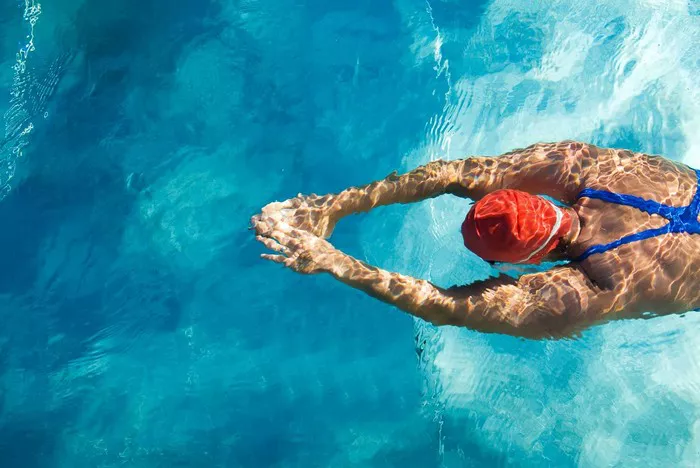Swimming is one of the most popular forms of exercise. It is not only enjoyable but also beneficial for health. This article explores how swimming affects the body, covering its physical, mental, and overall health benefits.
Overview of Swimming
Swimming is a low-impact aerobic exercise. It involves moving through water using various strokes like freestyle, breaststroke, backstroke, and butterfly. Because water supports the body, swimming puts less strain on joints and muscles compared to land-based exercises.
Physical Benefits of Swimming
Cardiovascular Health
Swimming is excellent for heart health. It increases heart rate and improves circulation. Regular swimming can lower blood pressure and cholesterol levels. This leads to a reduced risk of heart disease.
Muscle Strength and Endurance
Swimming works almost every muscle group. The resistance of water is greater than air, making muscles work harder. This builds strength and endurance. Different strokes target different muscles. For example, the freestyle stroke primarily works the arms and core, while the breaststroke focuses more on the chest and legs.
Flexibility
Swimming promotes flexibility. The various movements involved in swimming help stretch muscles and improve joint range of motion. Strokes require different arm and leg movements that can enhance overall flexibility.
Weight Management
Swimming burns calories effectively. The number of calories burned depends on the swimmer’s weight, speed, and stroke used. For instance, a 160-pound person can burn around 423 calories per hour swimming freestyle at a moderate pace. This makes swimming a great option for weight management.
Respiratory Benefits
Swimming enhances lung capacity. The controlled breathing techniques used in swimming train the respiratory system. This can improve overall lung function and increase oxygen intake. As swimmers learn to regulate their breathing, they can improve endurance in other physical activities.
Mental Benefits of Swimming
Stress Relief
Swimming can significantly reduce stress levels. The rhythmic nature of swimming, combined with the soothing properties of water, can calm the mind. Many swimmers report feeling relaxed and less anxious after a swim.
Improved Mood
Swimming releases endorphins, which are hormones that promote feelings of happiness. Regular swimming can help alleviate symptoms of depression and anxiety. This makes swimming a natural way to boost mood.
Enhanced Cognitive Function
Engaging in regular physical activity like swimming can improve brain health. Studies show that aerobic exercises increase blood flow to the brain. This can enhance memory, attention, and overall cognitive function.
Social Benefits of Swimming
Building Community
Swimming can foster social connections. Whether in a team setting, a class, or at a local pool, swimming brings people together. This can enhance feelings of belonging and community.
Teamwork and Discipline
Joining a swim team or participating in group classes teaches discipline and teamwork. Swimmers learn to work together toward common goals. These skills can be beneficial in other areas of life.
Health Benefits Beyond Exercise
Low Impact on Joints
Swimming is gentle on the body. The buoyancy of water supports body weight, reducing the risk of injury. This makes it suitable for people of all ages, including those with arthritis or other joint issues.
Rehabilitation and Recovery
Swimming is often used in rehabilitation programs. The low-impact nature of swimming helps individuals recover from injuries. It allows them to regain strength and mobility without placing too much stress on their bodies.
Improved Sleep
Regular physical activity, such as swimming, can promote better sleep. Swimming helps regulate sleep patterns. Many swimmers report improved sleep quality after incorporating swimming into their routine.
Swimming Techniques and Their Effects
Freestyle
Freestyle is the fastest and most common swimming stroke. It engages the core, arms, and legs, providing a full-body workout. This stroke improves cardiovascular fitness and muscle strength.
Breaststroke
Breaststroke is slower but requires more strength. It focuses on the chest, arms, and legs. This stroke helps build endurance and is great for beginners.
Backstroke
Backstroke is performed on the back. It improves flexibility in the shoulders and strengthens the back muscles. This stroke is also excellent for improving overall body posture.
Butterfly
Butterfly is one of the most challenging strokes. It requires strength and coordination. This stroke builds upper body strength and enhances cardiovascular fitness.
Tips for Getting Started with Swimming
Find a Suitable Location
Choose a pool or natural body of water that is safe and accessible. Consider local community centers, gyms, or swimming clubs.
Get Proper Gear
Invest in a good swimsuit, goggles, and swim cap if needed. These items can enhance comfort and performance.
Start Slowly
If you are new to swimming, begin with shorter sessions. Gradually increase the duration and intensity as you become more comfortable.
Take Lessons
Consider taking swimming lessons to learn proper techniques. This can improve efficiency and reduce the risk of injury.
Set Goals
Set achievable swimming goals, whether for fitness, competition, or personal enjoyment. Having goals can motivate you to stick with a swimming routine.
Safety Considerations
Learn to Swim
If you don’t know how to swim, take lessons. Learning basic swimming skills is essential for safety.
Swim with a Buddy
Always swim with a friend or family member. This ensures that help is available in case of emergencies.
Be Aware of Water Conditions
Pay attention to water conditions. Understand currents, tides, and weather conditions if swimming in natural bodies of water.
Use Lifeguarded Areas
Choose swimming areas that have lifeguards on duty. This adds an extra layer of safety.
Conclusion
Swimming is an effective way to enhance physical and mental health. Its numerous benefits make it suitable for people of all ages and fitness levels. Whether for fitness, relaxation, or socialization, swimming can positively affect the body and mind. By incorporating swimming into your routine, you can enjoy a healthier and happier life.
Related topics:
- How to Push Off the Wall in Swimming
- Which is the Best Paddle Board to Buy?
- The Best Cheap Jet Ski: A Comprehensive Guide

